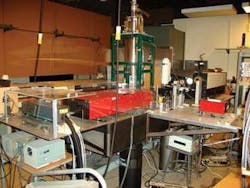ULTRAFAST LASERS: Femtosecond pulses kill viruses, leave human cells alone
Scientists have found a completely novel use for lasers in health care: killing viruses in blood. The technique has promise for disinfecting blood before transfusions, and reducing the viral load of patients with HIV, hepatitis C, and other diseases.
The idea arose in a conversation between Shaw-Wei Tsen, a biology student at Johns Hopkins University (Baltimore, MD), and his father, Kon-Thon Tsen, a laser expert at Arizona State University (Tempe, AZ). The younger Tsen described his work in a Johns Hopkins pathology lab, where he learned that scientists didn’t have a good method to cleanse pathogens from blood. For example, heat denatures blood proteins and kills body cells; chemicals can trigger serious side effects or become ineffective when microbes develop resistance; microwaves heat up surrounding molecules before they can zap pathogens, and they mutate cell DNA as well; ultrasound must be tuned to kill different viruses. This lack of options has forced hospitals and blood banks to discard contaminated blood that might otherwise help ailing patients.
The more the elder Tsen learned about the problem, the more he realized lasers could be the answer. He had studied the effects of lasers on crystal lattices, which can be made to vibrate and crack when excited by light. Like a crystal, the outer protein coat, or capsid, of a virus consists of repeating subunits. He believed that low-average-power visible-light lasers, which penetrate water with little absorption, could deliver enough energy to shatter capsids but leave blood components intact.
Over the next several years, the father and son developed a virus-killing system using a commercially available femtosecond laser. A Ti:sapphire laser produces 80 fs pulses at a wavelength of 850 nm and a repetition rate of 80 MHz. The beam passes through a frequency-doubler and gets converted to violet (425 nm) light in pulses with a duration of 100 fs and a spectral width of about 60 cm-1. A lens focuses the light beam onto the virus sample.
Tsen and colleagues tested the system on harmless M13 phage viruses that only infect E. coli bacteria. They spiked saline solution with known concentrations of virus, and then irradiated the samples. The treatment reduced the amount of live virus in the sample by 100- to 1000-fold. They found a steep dropoff in surviving viruses at an excitation-laser power density of greater than 50 MW. It is the first time that low-power lasers have been shown to inactivate viruses.
Different vibrational frequencies
The system seems to kill viruses with great efficiency while keeping human cells intact. The scientists suspect the laser polarizes the capsid, causing it to vibrate and shatter. The laser can polarize microbes with a wide range of vibrational frequencies, allowing it to inactivate many types of pathogens. Meanwhile, the laser’s low-power pulses help keep the surrounding liquid cool enough for body proteins and cells to survive. The technique is safe for human cells because they are more than an order of magnitude larger than viruses and vibrate at a very different frequency. The large size of human cells also means they are surrounded by many water molecules that can help dampen inadvertent vibrations. The bilayered structure of human cell membranes may offer additional protection from the laser’s pulses. While current tests suggest the laser can be tuned to kill bacteria while keeping human cells intact; the researchers aren’t sure how the light will affect small blood components such as platelets and other proteins.
The most immediate application of the technique would be for blood banks and hospitals. Lasers, says Tsen, could help eliminate unwanted microbes from blood being used for transfusions. “Right now, nobody knows if the blood you transfuse is safe; some diseases emerge as much as 10 years later.”
Tsen also envisions a time when patients with serious infections could have their blood cleansed of pathogens by laser, much the way kidney patients undergo dialysis. “We could use this method to tremendously reduce the amount of HIV or hepatitis C virus in patients. Once that viral load is reduced, drugs and the body’s own immune system could do a better job of fighting the disease.” HIV patients who have read about the system are already asking Tsen if they can participate in any future clinical trials. Tsen is now working with biologists, including an HIV expert at Arizona State, to make such a device a reality.—Kathleen M. Wong
REFERENCE
1. K.T. Tsen et al., J. Phys.: Condensed Matter19, 322102 (2007); www.iop.org/EJ/article/0953-8984/19/32/322102/cm7_32_322102.html
Kathleen M. Wong is a freelance science writer living in Oakland, CA.; e-mail: [email protected].
